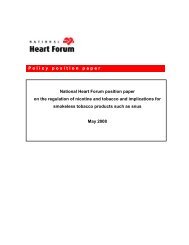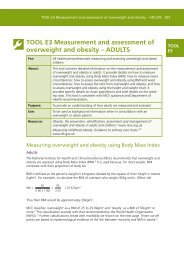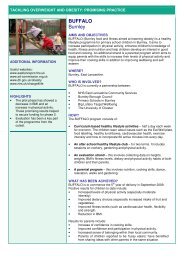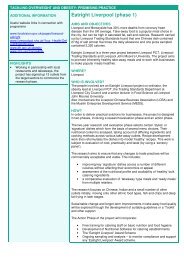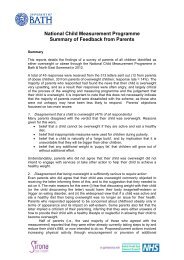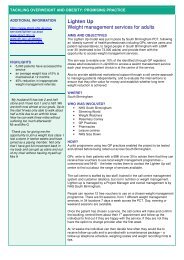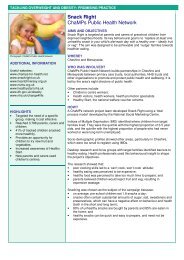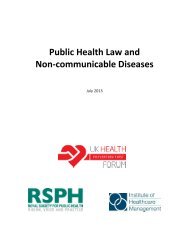The Challenge of Non-Communicable Diseases and Road Traffic ...
The Challenge of Non-Communicable Diseases and Road Traffic ...
The Challenge of Non-Communicable Diseases and Road Traffic ...
Create successful ePaper yourself
Turn your PDF publications into a flip-book with our unique Google optimized e-Paper software.
44 <strong>The</strong> <strong>Challenge</strong> <strong>of</strong> <strong>Non</strong>-communicable <strong>Diseases</strong> <strong>and</strong> <strong>Road</strong> <strong>Traffic</strong> Injuries in Sub-Saharan Africa<br />
value” principles [270], which combine economic <strong>and</strong><br />
social concerns, could help redress road infrastructure<br />
deficits <strong>and</strong> implement the road safety agenda in<br />
Africa. This approach is needed to generate collective<br />
action <strong>and</strong> help win political <strong>and</strong> community support<br />
to implement the African <strong>Road</strong> Safety Action Plan<br />
2011-2020, forge public <strong>and</strong> private partnerships to<br />
share the cost <strong>of</strong> enhanced infrastructure <strong>and</strong> interventions,<br />
<strong>and</strong> build institutional <strong>and</strong> management capacity<br />
to deal effectively with road safety challenges.<br />
Protection against Environmental<br />
<strong>and</strong> Occupational Risk Factors<br />
Particular hazards include those within the home,<br />
for example indoor air pollution from use <strong>of</strong> stoves<br />
burning solid fuels, exposure within the workplace<br />
(for example in particular industries such as mining<br />
<strong>and</strong> agriculture), <strong>and</strong> exposure in the outdoor<br />
environment to solar radiation, urban air pollution,<br />
<strong>and</strong> hazardous industrial <strong>and</strong> household waste [43].<br />
Relatively low-cost, population-level prevention<br />
measures lie with environmental <strong>and</strong> occupational<br />
legislation <strong>and</strong> regulation, although environmental<br />
protection <strong>and</strong> occupational health st<strong>and</strong>ards need<br />
to be monitored <strong>and</strong> enforced. Examples include<br />
worker protection through health <strong>and</strong> safety measures;<br />
safe use <strong>of</strong> dangerous substances; as well as regulations<br />
to reduce contamination <strong>of</strong> drinking water<br />
<strong>and</strong> soil to protect the public <strong>and</strong> environment <strong>and</strong><br />
bans on the use <strong>of</strong> asbestos. Better food storage could<br />
reduce aflatoxin-related liver cancers, <strong>and</strong> improved<br />
water <strong>and</strong> sanitation could reduce the spread <strong>of</strong> infectious<br />
agents such as helicobacter pylori which are<br />
linked to cancers. Enabling families to switch from<br />
traditional fires to fuel-efficient ventilated stoves that<br />
fit their lifestyles would dramatically reduce harmful<br />
indoor air pollution, carbon emissions, <strong>and</strong> use<br />
<strong>of</strong> wood fuel [271]. Policies that combine promotion<br />
<strong>and</strong> facilitation <strong>of</strong> active urban travel through<br />
walking <strong>and</strong> cycling alongside those promoting lower-emission<br />
motor vehicles are a potential win: win<br />
for both public health <strong>and</strong> climate change [272].<br />
Promoting the Health <strong>of</strong> Individuals,<br />
Families, <strong>and</strong> Communities<br />
Opportunities for health promotion occur throughout<br />
the life-course but particularly at significant<br />
events or transition points in people’s lives, for example,<br />
entering school, starting work, becoming a<br />
parent, <strong>and</strong> retirement [273-275]. Behavioral strategies<br />
in SSA need to take account <strong>of</strong> the socio-cultural<br />
context <strong>and</strong> consider whether <strong>and</strong> which interventions<br />
at individual, family, or community level<br />
are likely to be effective[114, 129].<br />
So-called settings approaches to health promotion<br />
are organized to reach defined populations in<br />
a holistic way in their everyday life, in places “where<br />
they learn, work, play, <strong>and</strong> love”. <strong>The</strong>se approaches<br />
in settings such as schools, workplaces, <strong>and</strong> prisons<br />
seek to develop health-supporting environments, incorporating<br />
the values <strong>of</strong> participation, equity, <strong>and</strong><br />
partnership. <strong>The</strong>re have been healthy cities initiatives<br />
in SSA (<strong>and</strong> other regions) for over a decade<br />
[276], <strong>and</strong> Africa has seen a significant development<br />
in health promotion in recent decades [277-278].<br />
Almost all the countries in SSA have structures in<br />
place for health education or promotion, some involving<br />
a diverse set <strong>of</strong> players, as in South Africa,<br />
Mauritius, <strong>and</strong> Ug<strong>and</strong>a. <strong>The</strong>re is a recognized need<br />
to build greater capacity <strong>of</strong> practitioners across government<br />
<strong>and</strong> community sectors, <strong>and</strong> to establish<br />
a sustainable financing mechanism [279-282]. Socalled<br />
‘sin taxes’ (on tobacco <strong>and</strong> alcohol) have been<br />
proposed as a means <strong>of</strong> funding health promotion<br />
foundations [283-284].<br />
HIV prevention <strong>and</strong> control is probably one <strong>of</strong><br />
the best examples <strong>of</strong> good health promotion in Africa<br />
<strong>and</strong> some <strong>of</strong> these skills <strong>and</strong> resources may be<br />
transferrable. <strong>The</strong>re is also potential for community<br />
health workers <strong>and</strong> other community cadres (for<br />
example agricultural extension workers <strong>and</strong> community<br />
nutrition workers) to be mobilized to support<br />
more integrated approaches at the community<br />
level. Most community health workers already have<br />
a strong health promotion element to their work,<br />
have been selected on the basis <strong>of</strong> being respected<br />
community members, <strong>and</strong> have the potential to act<br />
as change agents at community level [285].<br />
Strengthening integrated health promotion systems<br />
<strong>and</strong> interventions that cover NCDs, communicable<br />
diseases, <strong>and</strong> maternal <strong>and</strong> child conditions<br />
is a key policy issue. For some countries, there has<br />
been a gradual weakening <strong>of</strong> health promotion units<br />
<strong>of</strong> ministries <strong>of</strong> health, which is linked to limited



